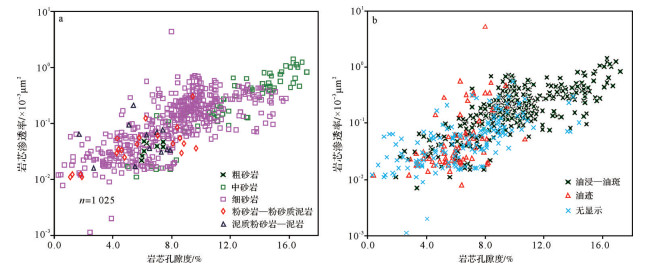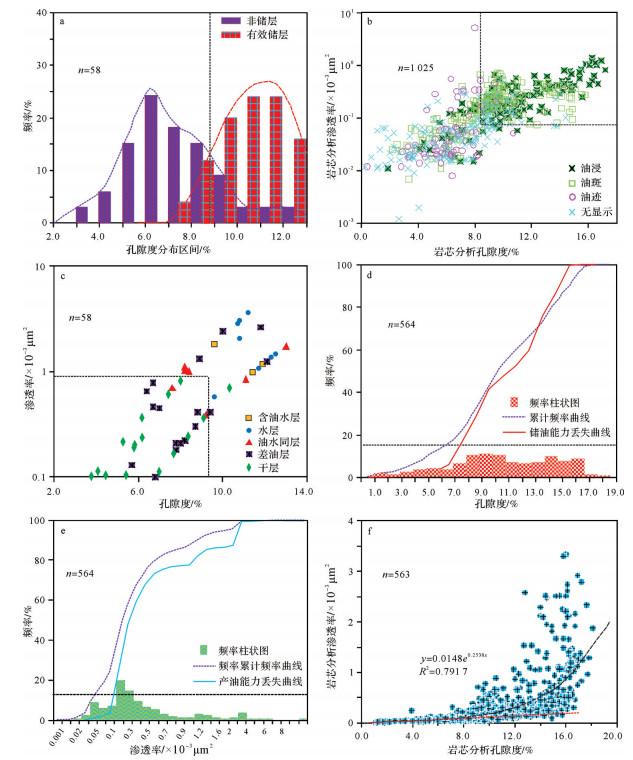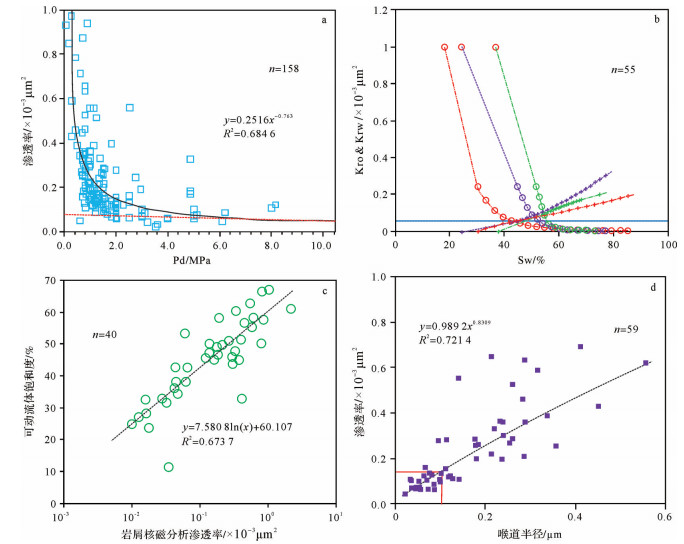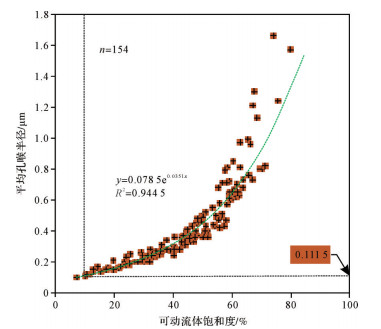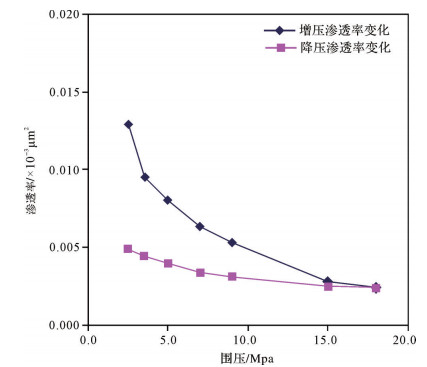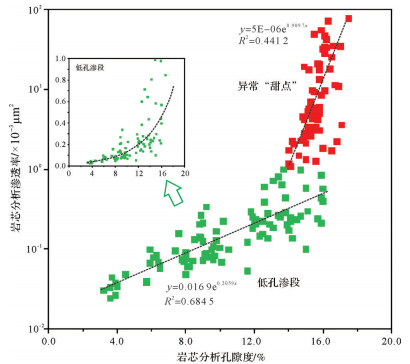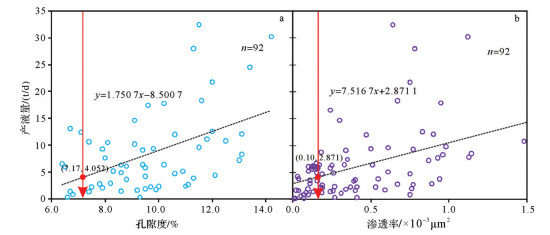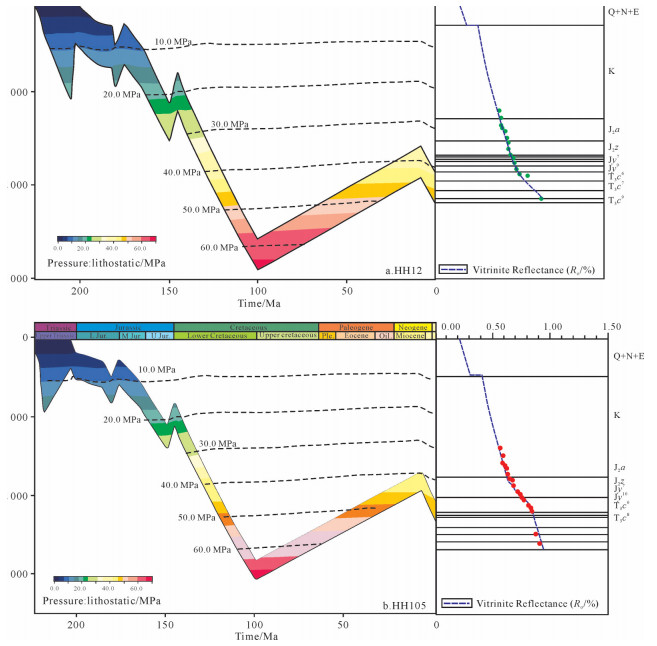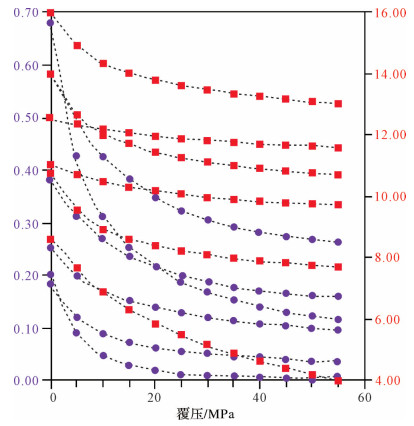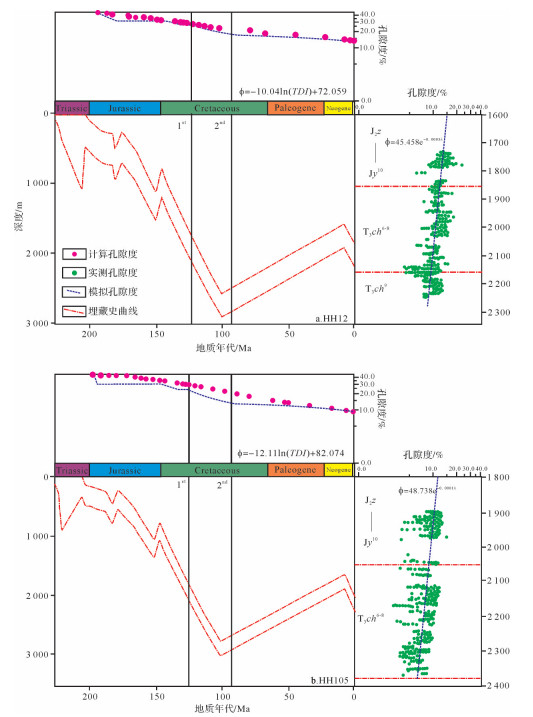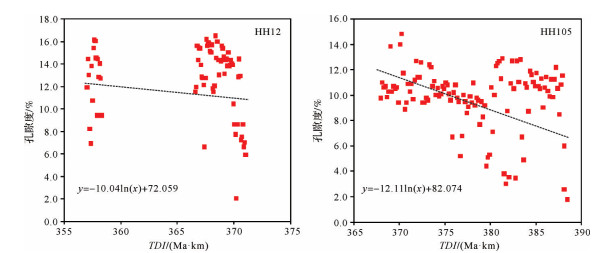HTML
-
鄂尔多斯盆地三叠系延长组广泛发育低渗透岩性油藏,其中长8油层组是本区富有潜力的勘探开发层位[1-2]。前人对镇泾区块延长组长6—长9油层组低渗透岩性油藏已进行了大量的研究,有效地指导了低渗透—致密岩性油气藏的勘探开发[3-6]。
储层临界物性是指在一定地层压力条件下,油气能进入储层所需的最小孔隙度及渗透率,是反映主成藏期油气充注临界物性的地史性参数[7-10]。“储层临界物性”的提出是对传统储层质量评价体系的补充,只有与成藏过程结合,动态地评价储层物性,才能客观地区分不同低渗透储层的含油气性。潘高峰等[11-12],石广仁等[13]利用砂岩烃类充注临界物性实验分析法等对低渗透储层临界物性进行分析,但是未考虑最大埋深之后成岩作用对孔隙的改造,从本质上说,埋藏成岩引起的储集岩孔隙度的缩减,也是一个热成熟作用的过程,成岩作用控制储集层的后期变化(压实、胶结和溶蚀等),是时间、温度、深度、压力等外因的函数,综合起来可以利用时深指数TDI(Ma·km)预测储层孔隙度[14-19]。
针对镇泾区块低孔低渗的特性,由于油气充注之后发生了地层的致密化过程,成藏期与现今孔隙度发生很大变化,但现今储层有效物性下限与储层临界物性之间有着必然的联系[10]。有效储层是指能够储集和渗流地下孔隙流体(主要为烃类和地层水),在现有工艺技术条件下能够采出具有工业价值产液量(烃类或与烃类同体积的水)的储集层。本文综合采取分布函数曲线法[20-23]、含油产状法[24-26]、物性试油法[20, 26-28]、驱替压力实验法[26-28]、油水相对渗透率法[29-30]、核磁共振法[26, 31]、最小流动孔喉半径法[21, 24-26, 28, 30, 32-34]、经验统计法[22-26, 28, 35]、渗透率应力敏感性法[38]、孔隙度—渗透率交会法[22-23]等十种方法以综合求取长8油层组有效储层的物性下限,这样可以消除因原始数据误差较大、基础数据数量较少、计算方法单一等引起的误差。然后基于孔隙度与时间、温度、深度、压力的函数关系[36-38],以地史模拟为基础,以初始孔隙度及实测孔隙度进行约束,利用时深指数TDI对致密储层的临界物性进行界定。
-
由粒度分析、砂岩薄片及含油级别综合统计表明,细砂岩的孔渗性较好,含油性为油斑及以上级别的砂岩主要为细砂岩,而粉砂—泥质粉砂岩、泥岩一般无含油显示,粗砂岩因粒度过大,反而不利于油气保存,由图 2可知,中砂岩—细砂岩物性最好,粗砂岩次之,泥岩—粉砂岩最差,据此确定本区有效储层岩性下限为油斑—油迹细砂岩。
-
利用上述确定的有效储层岩性下限,选取镇泾区块8口井(图 1b)的长8油层组细砂岩进行常规物性、压汞分析、核磁共振、相渗透率、覆压孔渗及应力敏感性试验进行低孔渗储层有效物性下限的综合取值,以求油气充注期临界物性的精确厘定。
-
通过在坐标系内分别绘制有效储层(主要包括油层、油水同层、含油水层及水层)与非储层(主要包括干层、差油层)的物性频率分布曲线[20-23],基于58个样品点所得两条曲线的交会点(图 3a)可知长8油层组孔隙度下限约为9.0%,利用孔隙度—渗透率交会图拟合孔渗关系(图 3f)得到渗透率下限约为0.15×10-3 μm2。
-
大量的岩芯分析资料表明,低孔渗储层的物性与含油性之间具有一定的相关性(图 3b),砂岩的含油产状随着物性变好而变好,由此根据含油产状对储层物性下限进行确定。多数油田含油级别达到油迹及油斑以上级别即可出油[24-26],由此长8油层组孔隙度下限为8.0%,渗透率下限为0.10×10-3 μm2。
-
利用8口取芯井的试油资料,结合单层孔隙度、渗透率平均值编绘产层(油层、水层、油水同层、含油水层)和非储层(干层、差油层)的岩芯孔渗交会图版(图 3c),由此长8油层组孔隙度下限为9.0%。
-
前人在统计岩芯实测孔隙度、渗透率数据的基础上,以低孔渗段累计储渗能力丢失占总累计的5%左右的物性值作为有效储层的孔渗下限[22-26, 28, 35]。考虑到长8油层组低孔渗的储层特点,以累计频率丢失不超过总累计的15%,累计储能丢失不超过总累计的10%进行统计。通过研究区长8油层组564块岩芯样品的孔隙度和渗透率数据,分别绘制孔隙度和渗透率的分布直方图、累计频率及累计能力丢失曲线(图 3d,e),由此长8油层组孔隙度下限为7.5%,渗透率下限分别为0.15×10-3 μm2。
-
根据长8油层组岩芯实测孔渗交会图(图 3f)可知,按趋势变化可将孔渗曲线大致划分为三段式:第一段的渗透率变化甚微,主要为表现为无渗透能力的孔隙;第二段的渗透率呈明显增加趋势,为具一定渗透能力的有效孔隙;第三段的渗透率表现为急剧增大的趋势,此段孔喉半径增大,岩石渗流能力较强并趋于稳定[22-23],以第一、二段的转折点作为划分储集层与非储集层的物性界点,由此长8油层组孔隙度下限为8.5%,长8油层组渗透率下限为0.11×10-3 μm2。
-
由驱替压力与渗透率的关系图(图 4a)分析表明,由于渗透率是表征岩石渗流能力的直观参数,驱替压力与渗透率呈幂函数关系,且驱替压力的变化具有一个明显的拐点,当渗透率低于拐点处渗透率值时,驱替压力梯度值迅速上升;当渗透率高于拐点处渗透率值时,驱替压力值的变化范围不大[26-28]。求取该拐点对应的渗透率值即为研究区致密砂岩储层的渗透率下限,然后结合孔渗交会图(图 4a),以渗透率的下限推算相应的孔隙度下限,由此长8油层组孔隙度下限为4.8%,渗透率下限分别为0.05×10-3 μm2。
-
前人一般利用油水相渗曲线的交叉点(等渗点)对应渗透率作为储层渗透率的下限标准[29-30],通过对工区内3口井利用非稳态法测定各油层组油水相对渗透率(图 4b),由此长8油层组孔隙度下限分别为4.8%,渗透率下限分别为0.05×10-3 μm2。
-
核磁共振技术采用孔隙度和可动流体空间大小来计算核磁共振分析孔隙度,并由核磁共振测量样品T2信号的幅度值,可以得到样品的可动流体饱和度和渗透率Knmr[25-26, 31, 39]:
(1) 式中:Knmr为核磁共振分析渗透率,ϕ nmr为核磁共振分析孔隙度,T2为截止值,该公式中C取值0.5。
在低孔渗油藏中,可动流体饱和度可作为评价油层物性优劣、确定产油能力下限的重要指标之一。结合研究区7口井岩芯样品的气驱法核磁测试结果(图 4c)和廊坊国家重点实验室对可动流体饱和度的下限标准(> 10%),长8岩屑核磁渗透率最小(0.034 7×10-3 μm2)的样品点对应可动流体饱和度为10.80%,因而0.04×10-3 μm2可以作为研究区长8储层开采下限值,对应的3.9%可作为孔隙度下限值。
-
一般将既能储集油气又能使油气渗流的最小喉道称为油气的最小流动孔喉半径。普遍认为0.1 μm厚度的束缚水相当于水湿性碎屑岩表面附着的水膜厚度[21, 24-26, 28, 30, 32-34],当喉道半径 < 0.1 μm时,油气难以克服极高的毛细管阻力进入储层。根据常规压汞实验,以0.1 μm作为研究区储层的最小流动孔喉半径,通过绘制喉道半径与渗透率的交汇图(图 4d),由此长8油层组孔隙度下限分别为9.0%,渗透率下限分别为0.15×10-3 μm2。
-
经验统计法、分布函数曲线法、物性试油法、含油产状法、孔渗交会法是基于大量致密砂岩储层的测井、录井统计数据为基础,从统计学角度出发的静态的方法;而核磁共振法、驱替压力实验法、最小流动孔喉半径法、渗透率应力敏感性法及油水相对渗透率法是基于致密砂岩储层微观孔隙结构及渗流特征为基础的动态模拟的方法。
致密砂岩储层具有非达西流、非均质性较强、储层裂缝异常发育及微细孔喉为特点,因而采用常规方法研究其下限具有一定的局限性,综合上述9种方法来看,剔除奇异值后,所得长8油层组孔隙度下限范围为4.8%~9.0%,渗透率下限范围依次为0.04~0.15×10-3 μm2,所得物性下限区间变化范围较大,为避免因研究方法单一和适用性受限而在对有效储层下限标准取值时产生较大的偏差,在此对上述几种常规方法进行优选。
(1)基于致密砂岩储层非均质性强的特征,储层物性主要呈现非正态分布,分布函数曲线法并不适用。
(2)由于大多致密砂岩储层样品渗透率均小于1×10-3 μm2,不能满足油水相渗的行业标准SY/T 5345—1999测试规范规定的渗透率不小于5×10-3 μm2的要求,且理论上应以残余油饱和度时的水相相对渗透率进行划分,只是因为拐点不易确定,实际上采用等渗点(交叉点)对应渗透率为储层渗透率的下限标准,故油水相渗测试结果也仅供参考。
(3)最小流动孔喉半径法是以常规储层设定的0.1 μm为水膜厚度,而致密储层因非达西流特性,束缚水的水膜厚度可能高于0.1 μm[26],本次研究利用核磁共振测井技术对最小孔喉半径进行确定为0.111 5 μm(图 5),因此运用最小流动孔喉半径法还需对致密储层水膜厚度进行统计。

Figure 5. Cross-plot of movable fluid saturation vs. average pore-throat radius for Chang 8 oil-bearing layer in the Zhenjing block
(4)通过对HH103、HH12等井的长8储层进行应力敏感性分析,由于送检样品渗透率均小于1×10-3 μm2,不能满足行业标准SY/T5358—2002测试规范渗透率不小于1×10-3 μm2的要求,且由于储层早已致密化,增压过程中应敏较小(图 6),可能导致误差较大,故致密储层不宜采用此方法进行划分。
(5)因致密储层一般裂缝较发育,导致“甜点”异常发育,由孔隙度储油能力、渗透率产油能力计算公式(公式2)所得累计曲线中储层“甜点”所占权重较大,导致误差较大。另外,储层“甜点”异常发育(图 7),可能导致孔渗关系无法确定孔渗曲线的“三段式”,故对于裂缝极其发育的致密储层,经验统计法及孔渗交会法也不适用。
(2) 式中:Qϕi:第i个样品孔隙度储油能力,%;QKi:第i个样品渗透率产油能力,%;ϕi:第i个样品孔隙度,%;Ki:第i个样品渗透率,×10-3 μm2;hi:第i个样品的长度,m。
综合以上分析,此次优选出驱替压力实验法、核磁共振与含油产状法相结合,基于统计学的原理对上述各种方法获得的物性下限求取平均值,最终确定研究区致密砂岩长8储层物性的下限范围为7.17%和0.10 ×10-3 μm2(表 1)。
方法 对致密储层的适用性 孔隙度/% 渗透率/(×10-3 μm2) 分布函数曲线法 曲线形态呈非正态分布,仅供参考 ≥ 9.0 ≥ 0.15 含油产状法 优选 ≥ 8.0 ≥ 0.10 物性试油法 非达西流渗流特征,使表征储油能力的孔隙度与表征产油能力的渗透率之间相关性较差 ≥ 9.0 — 驱替压力实验法 非均质性强,孔隙结构复杂,非达西流,优选 ≥ 4.8 ≥ 0.05 油水相对渗透率法 < 5 ×10-3 μm2,测试仅供参考 ≥ 4.8 ≥ 0.05 核磁共振法 反映致密储层孔隙结构的复杂性,优选 ≥ 3.9 ≥ 0.04 最小流动孔喉法 水膜厚度采用常规储层标准(0.1 μm),致密储层束缚水水膜大于0.1 μm,仅供参考 ≥ 9.0 ≥ 0.15 经验统计法 基于大量致密储层的物性统计数据为基础,对储层甜点异常发育区不适用(如长9) ≥ 7.5 ≥ 0.15 孔隙度—渗透率交汇法 储层甜点异常发育,无法确定三段式 ≥ 8.5 ≥ 0.11 渗透率应力敏感性法 < 1 ×10-3 μm2,且储层早已致密化,应敏较小可能导致误差较大 — — 综合取值 剔除奇异值,求取均值 ≥ 7.17 ≥ 0.10 Table 1. Effective lower limits of Chang 8 oil-bearing layer in the Zhenjing block
依据石油天然气行业标准[40],油层埋深1 000~2 000 m时,试油产液量必须 > 1 t/d属于工业油层,油层埋深2 000~3 000 m时,试油产液量必须 > 3 t/d属于工业油层。通过对长8油层组试油层段的产液量与储层物性进行交会(图 8),可知按照上述综合取值,有效储层最低产液量为2.871~4.052 t/d,符合该地区致密储层的工业油流标准。
3.1. 分布函数曲线法
3.2. 含油产状法
3.3. 物性试油法
3.4. 经验统计法
3.5. 孔隙度—渗透率交会法
3.6. 驱替压力实验法
3.7. 油水相对渗透率法
3.8. 核磁共振法
3.9. 最小流动孔喉半径法
3.10. 储层物性下限确定方法对致密储层的适用性
-
由于沉积微相对储层物性起控制作用,选取代表不同沉积微相的HH12和HH105井对储层临界物性进行厘定。通过进行压力演化史(图 9)恢复,长8段地层现今埋深等效压力约为45 MPa,经历最大埋深时地层压力为60 MPa左右,由覆压孔渗实验(图 10)可知,长8段地层的压实作用持续至今。因此,在进行孔隙度预测之前,需要对地层进行去压实恢复及剥蚀量恢复。

Figure 10. Relationship between physical properties andoverburden of Chang 8 oil layer, Zhenjing block
根据声波时差法计算HH12、HH105等井的剥蚀量进行剥蚀量补偿。
Athy[32]和Bloch[38]指出岩石孔隙度与深度之间存在指数关系:
(3) 式中:ϕ(h):孔隙度;ϕ0:初始孔隙度;c:压实系数(1/m);h:埋深。根据不同深度地层岩石的孔隙度测量值,在对数坐标中拟合指数函数做出ϕ-h关系曲线(图 11),从而可以得到HH12井ϕ0为45.458%和c为0.000 3;HH105井ϕ0为48.738%和c为0.001。从初始孔隙度和压实系数来看,HH12可能以砂岩为主,和HH105岩性可能以泥岩为主,这与两口井延长组沉积期沉积微相不同有关[15, 17]。可用压实系数来恢复沉积地层在不同地质时期的原始地层沉积厚度,即去压实恢复[36-38]。

Figure 11. Porosity section by the accumulation period, showing the critical properties forChang 8 oil-bearing layer in the Zhenjing block
岩石骨架厚度(hs)如下计算:
(4) 由此得出:
假设地层骨架厚度不变,则可得:
式中:h4,h3为某一层位原始顶底面埋深;h2,h1为某一层位现今的顶底面埋深。因此根据迭代法在已知现今顶、底埋深的基础上,求出长8油层组的原始顶面埋深。
-
由于产生岩石颗粒有效应力与孔隙流体应力的根本原因在于上覆地层产生的负荷,故孔隙度大小可用上覆负荷表示,即:
(5) σ:上覆负荷。
如果考虑时间因素,由马克斯韦尔黏弹性蠕变曲线可知岩石的应变量ε与时间t呈线性关系:
(6) 式中:ε:应变;σ0:应力;E:弹性模量;η:黏性系数;t:时间。
在小变形情况下,应变基本上反映介质孔隙度的改变量,即:
(7) 故存在:
(8) 如果将压实过程分解为一系列蠕变过程,则任意时间t的孔隙度ϕ可以对公式(8)求和得:
(9) 式中:ϕ0:初始孔隙度(沉积初期);σ(t):随时间变化的上覆压力,MPa。
Sombra et al.[14]于1997年首次使用时深效应指数TDI探讨与砂岩储层孔隙度的相关性,进而预测储层孔隙度。
(10) hi(t)为不同地质时期埋藏深度随时间变化的函数,km。
从式(9)和(10)可知,孔隙度ϕ和TDI均与作用时间(t)呈线性关系,不同之处在于孔隙度受上覆负荷压力σ(t)影响,而TDI则与地层埋深h(t)有关。另一方面,上覆负荷与埋深呈正比,即:
(11) 式中,a,b:系数;σ(t):上覆负荷。
以上分析与刘震等[18]2007年提出的地下岩石孔隙度的时间与深度双元函数模型相符:
(12) 式中,a、b、c、ϕ0为常数。
因此,孔隙度ϕ与TDI都是埋深和地质时间的函数,尝试通过建立TDI与ϕ之间的关系,对致密储层临界物性进行分析。通过关系拟合(图 12),对数关系拟合最优[17]。
(13) a代表各种沉积和成岩参数对孔渗的综合影响,它综合反应了诸如颗粒粒径、矿物分选性、岩性岩相、早期压实、胶结、溶蚀等多种因素的影响。利用HH12、HH105拟合方程对孔隙度进行预测,利用现今实测孔隙度(ϕ)及初始孔隙度(ϕ0)对预测孔隙度曲线进行端点约束(图 11)。
对于储层临界物性ϕlimit等于现今储层有效下限值ϕe加上成藏后孔隙度变化量△ϕ。
(14) 结合流体包裹体特征分析及构造演化史进行了成藏期次分析,可知长8油层组主成藏期对应135~125 Ma及95~82 Ma。由拟合所得的方程进行计算,可知△ϕt=90约为9.54%~10.34%,△ϕt=130约为19.84%~19.92%,结合所确定的储层物性下限通过式(14)计算得出,第一期充注(130 Ma)的临界物性为27.01%~27.09%;第二期充注(90 Ma)的临界物性为16.71%~17.51%。结合前人对镇泾区块长8—长9油层组的成岩相研究,油气成藏期之后储层发生了较严重的化学压实、方解石—硅质胶结作用导致储层物性大幅度降低[4-6, 30],自油气充注以来储层发生了较严重的致密化过程。
4.1. 剥蚀量恢复及去压实恢复
4.2. 地史演化中的储层成藏临界物性
-
(1)结合粒度分析资料、砂岩薄片资料及含油级别综合统计基础上确定本区有效储层岩性下限为油斑—油迹细砂岩。在长8油层组细砂岩测井解释、试油数据、常规物性、压汞分析、核磁共振、相渗透率、覆压孔渗及应力敏感性试验等地质资料的基础上,根据统计学原理和超低渗透油藏流体渗流机理,通过对比多种常规有效物性下限评价方法的优缺点,优选出适用于致密砂岩储层的核磁共振法、驱替压力实验法和含油产状法,并综合得出长8油层组有效储层下限为7.17%和0.10×10-3 μm2。
(2)基于地史模拟及有效储层下限综合取值,得出长8油层组两期油气充注的临界物性约为27.0%和17.0%。结合前人对镇泾区块长8—长9油层组的成岩相研究认为,自油气充注以来储层发生了较严重的致密化过程。

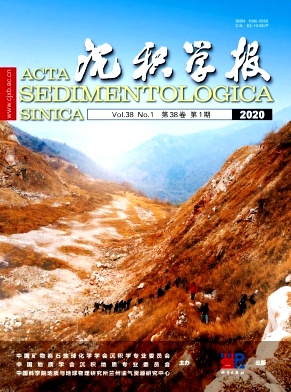


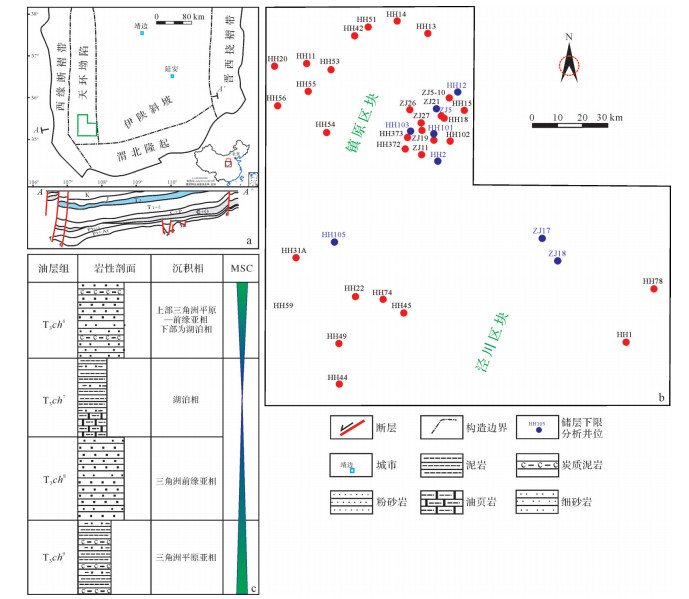



























 DownLoad:
DownLoad:
